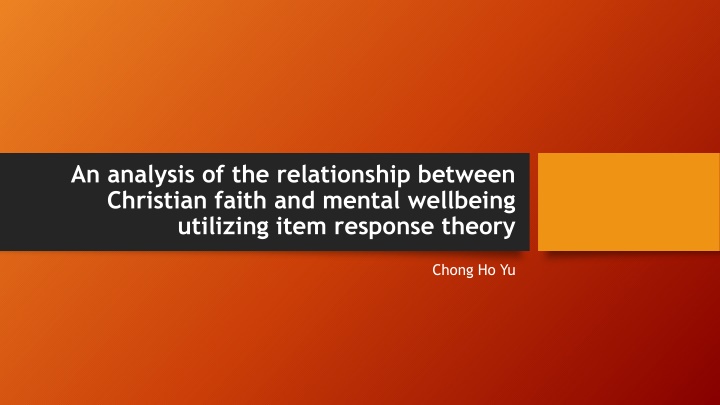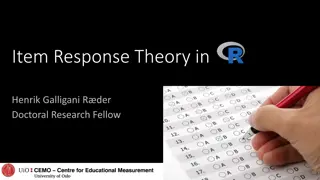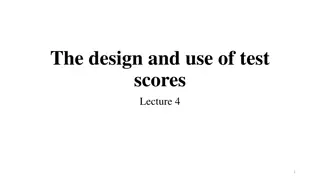
Exploring the Link Between Christian Faith and Mental Wellbeing
Investigating the impact of Christian faith on mental health among American university students using item response theory. Recent studies show increasing levels of distress and mental disorders, with a focus on depression, anxiety, and suicide-related outcomes. Data sourced from a survey conducted at a Christian university in the American Southwest among undergraduate students.
Download Presentation

Please find below an Image/Link to download the presentation.
The content on the website is provided AS IS for your information and personal use only. It may not be sold, licensed, or shared on other websites without obtaining consent from the author. If you encounter any issues during the download, it is possible that the publisher has removed the file from their server.
You are allowed to download the files provided on this website for personal or commercial use, subject to the condition that they are used lawfully. All files are the property of their respective owners.
The content on the website is provided AS IS for your information and personal use only. It may not be sold, licensed, or shared on other websites without obtaining consent from the author.
E N D
Presentation Transcript
An analysis of the relationship between Christian faith and mental wellbeing utilizing item response theory Chong Ho Yu
Problem More and more American university students suffer from mental distress or disorder. The current study aimed to verify these previous findings with a novel contribution, namely, the use of item response theory
Lit review Center for Collegiate Mental Health (CCMH) indicates that distress levels for depression, generalized anxiety, and social anxiety have been increasing since 2012. In 2018 73% of participants (n=264,681) had depression scores above the cutoff, compared with 70% in 2010 (n=87,884).
Lit review The National Survey on Drug Use and Health (NSDUH; n=611,880) indicates that from 2005 to 2017, rates of major depressive episode substantively increased (from 8.7% to 13.2%) among adolescents aged 12 to 17. Among young adults aged 18 to 25, severe psychological distress and suicide-related outcomes, such as suicidal ideation, plans, attempts, and deaths, also increased by 71% between 2008 and 2017.
Lit review Entwistle, Eck, and White (2019) found that the top five mental issues reported by college students are anxiety, stress, interpersonal concerns, family relationships, and depression. 15 to 43% of participants had prior therapeutic experience, 10-11% are currently on medications, and 33% have used the Counseling Center previously. 7-10% of counseling sessions involved crisis situations, and student hospitalizations substantively increased.
The relationship between religion and mental health Agnostic Atheist Buddhist Catholic Christian Hindu Jewish Muslim No Self- preference identified Depression 80% 79% 78% 68% 70% 78% 64% 78% 76% 78% Generalized anxiety 78% 75% 74% 69% 69% 72% 69% 72% 74% 76% Social anxiety Academic anxiety Family stress Thought of ending life 68% 68% 61% 53% 54% 57% 49% 55% 61% 61% 73% 72% 71% 63% 65% 71% 56% 77% 70% 70% 66% 65% 68% 49% 56% 52% 47% 65% 64% 70% 46% 47% 45% 31% 33% 38% 28% 36% 41% 45% Suicide attempt 12% 12% 16% 6% 8% 8% 6% 8% 11% 16%
Data source A survey administered by the health center in a Christian university in the American Southwest. 496 undergraduate students participated in the survey. 315 are females (72.4%), 119 are males (27.35%), and 1 is transgender (0.002%). The mean age of the sample is 20.23, and the standard deviation is 2.25.
Independent variable: Faith status I continue to attend church and have faith in Christ I have not attended church for over one year but I maintain my faith in Christ I still attend church but have serious doubts of my faith in Christ I am not attending church and have abandoned my faith in Christ.
Dependent variable: Mental wellbeing This variable is the IRT s severity score derived from 45 questions in a standard survey administered by a university health center (see the list below). Three items were removed later due to psychometric issues e.g. Ever-Felt things were hopeless Ever-Felt overwhelmed by all you had to do Ever-Felt exhausted (not from physical activity) Ever-Felt very lonely Ever-Felt very sad
Data analysis The measures of mental health are reduced by item response theory instead of factor analysis, which is tied to the paradigm of classical test theory. in a traditional composite score all items are treated equally, but some mental issues are significantly more severe than others. For example, no doubt suicide ideation and attempts are worse than loneliness and sadness. In other words, even if two persons have the same composite scores, their mental health conditions could be vastly different. IRT estimates the person attribute and the item attribute simultaneously
Dot plot of item attributes According to Linacre (2017), if the mean square (a measure of misfit) is larger than 2, then the item might distort the entire measurement system. Alternate way: the dot plot indicates that only three items significantly deviate from the majority, and thus they were removed from the subsequent analysis.
Severity of mental issues (part of it) Item Last 12 months diagnosed/treated-Schizophrenia Last 12 months diagnosed/treated-Phobia Last 12 months diagnosed/treated-Bipolar Disorder Ever-Attempted suicide Last 12 months diagnosed/treated-Bulimia Last 12 months diagnosed/treated-Substance abuse or addiction (alcohol or other drugs) Last 12 months diagnosed/treated-Other addiction (e.g., gambling, internet, sexual) Last 12 months diagnosed/treated-Other sleep disorder Last 12 months diagnosed/treated-Anorexia Last 12 months diagnosed/treated-Obsessive Compulsive Disorder (OCD) Last 12 months diagnosed/treated-Other mental health condition Severity 6.7672 6.0666 5.6537 5.3589 5.1284 5.1284 5.1284 4.9390 4.5125 4.4004 4.2982
Test information function The IRT algorithm estimated the item information function (IIF) of each mental condition. The test information function (TIF), was constructed by summing all IIFs. This TIF reveals that in this study more precise information can be obtained for students whose theta score (a measure of mental condition) is 2.
Dual plot Many severe mental diseases were beyond most students. Only a few students suffered from severe mental conditions, such as suicide attempts. The majority centered on zero (average), and some students earned a negative score, meaning that they were relatively healthy.
Comparison of theta score and composite score In traditional composite scores, for some students the severity of mental conditions was either over-estimated or under-estimated. The distribution of the composite scores conveys a false sense of security because it seems that most students are concentrated toward the lower end. However, this contradicts the national data showing an alarming trend.
Faith as a protective factor (Overall) 1 = I continue to attend church and have faith in Christ 2 = I still attend church but have serious doubts of my faith in Christ 3 = I have not attended church for over one year but I maintain my faith in Christ 4 = I am not attending church and have abandoned my faith in Christ
Diamond plot 95% confidence interval: population mean might be as high as the upper bound of the diamond or as low as the lower bound. Participants who continue to attend church and keep their faith outperformed all other groups.






















